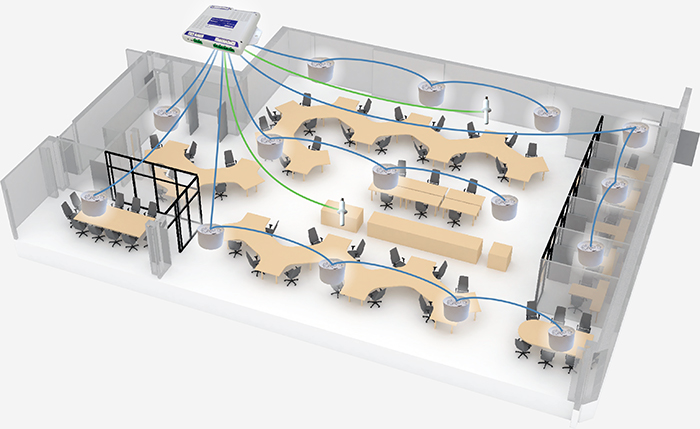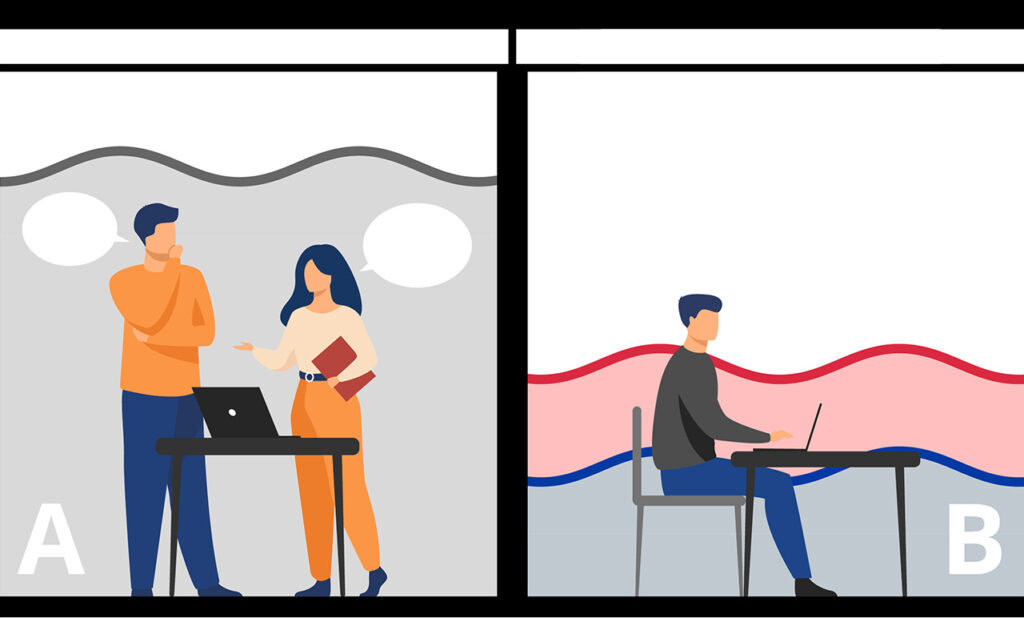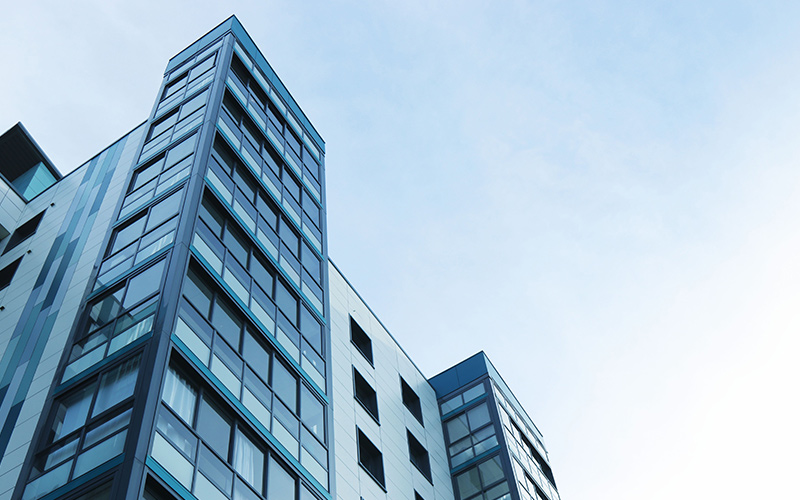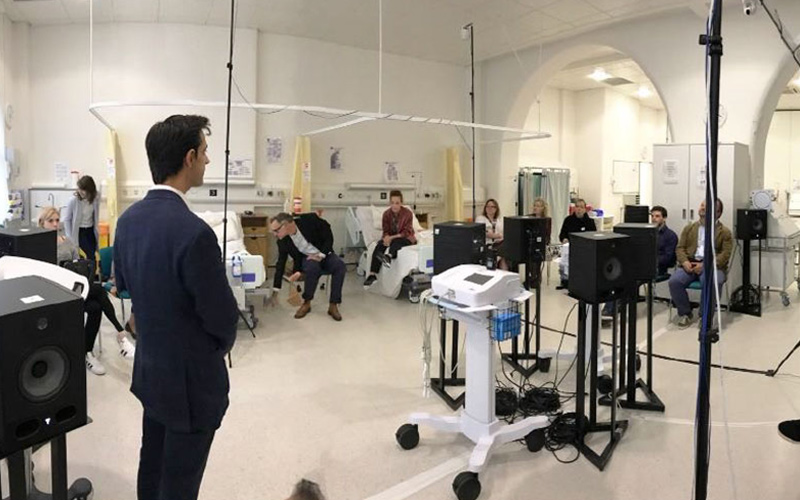SPeech Privacy
Sound Masking will improve wellbeing and increase productivity
Modern offices usually have a very low ambient noise level because they’re well-insulated, our computers are fan-less and some are on upper floors far away from any street noise.
This means staff will unintentionally overhear private conversations around them and will be continuously distracted by even the faintest noises. This can be an uncomfortable and stressful situation that most people in open offices are all too familiar with.
To address this problem, sound masking systems generate a soft, subtle background sound, similar to airflow. Using specially-designed loudspeakers hidden throughout the space – usually above the ceiling tiles. The speakers are connected to a controller which will automatically manage noise levels and support your staff to be more productive and increase their wellbeing.
The office soundscape will become more uniform, more relaxed and noisy distractions are effectively muffled out This provides staff with a greater sense of sonic privacy, makes it much easier to concentrate on their tasks and afford them additional speech privacy without building meeting rooms.

Sound Masking can solve two of the biggest complaints about open-plan offices
Looking at the data, noise – too much or too little – has a huge impact of staff and will even drain morale.
As we favour layouts which make the most of natural light and views of the outside, there are no physical barriers to block sound from travelling across the space. The modern office has swapped meeting rooms for ‘open collaboration’ areas which look great and convey a sense of visual welcoming. It’s only when you’re sitting in those areas that you realise you can hear everyone else’s conversations and, that they can hear yours.
With the addition of a sound masking system, you guarantee a higher level of speech privacy for everyone and even encourage collaboration as staff don’t feel they’re distracting others and they know their conversations are private.
Sometimes, even a meeting room won’t guarantee speech privacy if the partition is not robust enough to block speech or if it only extends to the suspended ceiling rather than the soffit above. Noise will first escape through the easiest route which is air gaps. Sound will most likely pass through the gaps around the door and over the partition walls into the corridor or adjacent meeting rooms.
We can see that sound or speech privacy is a key indicator of staff satisfaction. One of the reasons we find speech privacy to be such a hot topic is because, we are drawn to conversation. When a conversation is intelligible (where the words are comprehensible), we find it almost impossible to ignore – even if we don’t want to listen.

Don’t take our word for it, here are what researchers have to say on the topic of sound masking...
“Appropriate sound masking is necessary to achieve acceptable speech privacy between two neighbouring workstations […] A significant improvement in objective speech privacy occurred after installing a sound masking system […] The need for further acoustic improvements became negligible because major acoustic problems no longer existed after installing a sound masking system.”
– Effects of sound masking on workers – a case study in a landscaped office – Valtteri Hongisto
“An ideal ambient noise level is approximately 45 dBA. If the noise level is much less, speech privacy will be substantially reduced. If it is much higher, the noise will be a source of annoyance and may reduce speech privacy because people will talk louder. The maximum noise level should therefore not exceed 48 dBA. Because it is important to achieve an ambient noise level within a very small range of levels, and because noise levels should be evenly distributed throughout the office, this is usually best achieved using electronic masking noise. Of course, this also allows the spectrum, as well as the level, of the masking sound to be optimally set to maximize the speech privacy without undue disturbance.”
– Criteria for Acoustic Comfort in Open-Plan Offices – Bradley, J. S.; Gover, B. N.
“The main argument in favour of open plan offices is the expected reduced cost relative to closed offices with full height partitions. The cost savings may be a little reduced with the extra expense of meeting acceptable speech privacy requirements. However, these additional costs are usually assumed to be small relative to the costs of decreased performance by distracted office workers […] A successful open office should include an optimum masking sound spectrum.”
– The Acoustical Design of Conventional Open Plan Offices – Bradley, J.S
“Sound masking systems can be used to add neutral background noise that will cover speech sounds and other distracting noises. Sound masking is an effective way to lower the speech intelligibility index (SII) and create good acoustical conditions. Laboratory simulations have also found that sound masking improves the execution of complex cognitive tasks and reduces perceived stress.”
– Workstation Design for Organizational Productivity – CNRC
Why you should consider adding sound masking to your office
Sometimes, even a meeting room won’t guarantee speech privacy if the partition is not robust enough to block speech or if it only extends to the suspended ceiling rather than the soffit above. Noise will first escape through the easiest route which is air gaps. Sound will most likely pass through the gaps around the door and over the partition walls into the corridor or adjacent meeting rooms.
See how in the diagram without sound masking, the receiver on the right, can hear Office A’s conversation? Their voices are louder than the ambient noise level in Office B. The noise could be travelling through the partition, over the partition or through both doors.
When you add sound masking, the noise source becomes unintelligible. Noise receiver won’t be able to discern the words of the conversation. Office A has speech privacy and Office B suffers no intelligible distraction from Office A.
WITHOUT Sound Masking

WITH Sound Masking


Sound masking and hybrid workplaces
In hybrid workplaces, staff might not sit at the same desk every day. Depending on their tasks for the day, staff can choose an area in the office most suited to their activity, usually focus work or collaborative – or both!
An activity-based or hybrid working environment also means that no two days are alike, especially in terms of work atmosphere. The office soundscape can vary a great deal throughout the week, from lively, all the way to silent on a dreary morning, all based on the evolving changing nature of employee activity and office occupancy.
In the end, there’ll always be staff who need to collaborate in proximity with others who need to focus alone, in peace.
Sound masking technology can help you reconcile these two very different needs within the same space.

LEED & WELL Building Standards advocate for sound masking
Find out more about LEED certification and WELL Building Standards in relation to sound masking.

Where can sound masking be used?
Financial Services
Retail Banking
Law Firms
Government Offices
Libraries
Hotels
Hospitals, GP surgeries and other medical practices should ensure speech privacy and patient confidentiality in exam rooms, reception and waiting areas. Intensive care units also use it to help patients sleep and recover better. We’ve been doing research into this here with the HPNOSS team, click here to read more.
Sound masking allows developers and engineers to interact effectively in open plan areas without disturbing those who need to stay focused. Software engineers can achieve flow state faster, oblivious to surrounding activity. Increasing overall productivity!
Working with the HPNoSS Symposium & Workshop
The HPNoSS Symposium & Workshop was held at the Chantler Simulation and Interactive Learning (SaIL) Centre, at the King’s Guys Campus.
Using a set of eight high-quality loudspeakers on stands (in kind support from the London College of Communication) a hospital soundscape was re-created in the Chantler Simulation Ward, using recordings made at an Intensive Care Unit at Chelsea & Westminster NHS Foundation Trust. Sound pressure levels (dB) and subjective measures were used to match the original environment.

Want to know more about Sound Masking?
Get in touch and speak with a member of the Sound Directions team to discuss your Sound Masking requirements.



